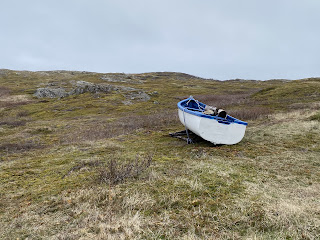Spillars Cove is a tiny community - population approximately 70 - just outside Bonavista. I loved hiked along the headlands here, and the coastline is spectacular!
The Act providing for the establishment of a lighthouse on Cape Bonavista was passed in the House of Assembly of Newfoundland in 1841 and construction began that year. It took two years to build, and in 1843 the light was put into operation. In 1962 the light at the Cape was automated and today the lighthouse is a historic site.
The original light, from 1895 - and just outside the window (in the fog), you can almost see the new, automated light currently in use.
In 1497 John Cabot (Giovanni Caboto) sailed from Bristol in the MATTHEW to seek a western passage to Asia. He made land somewhere on the east coast of Canada. Although the sources do not allow unequivocal identification of the site, local tradition records Cape Bonavista as the landfall.
The unusual rock formation known far and wide as the Dungeon. It is essentially a twin entranced sea cave with a collapsed roof, which has been carved into the cliff face.
Memorial United Church is constructed entirely of wood and was built during the period 1918-1923 and dedicated to the memory of parish members who paid the supreme sacrifice of their country during the First World War.
Built in 1907, The Orange Lodge Hall is the largest fraternal hall of wooden construction in North America.
The Provincial Court House building in Bonavista, built in 1900. On the grounds are an old carriage gun from WW1, replicas of the whipping post and a set of stocks.
The white, 19th century clapboard buildings of The Ryan Premises National Historic Site commemorate five centuries of commercial fishing on Canada’s east coast.
The Proprietor’s House


































No comments:
Post a Comment